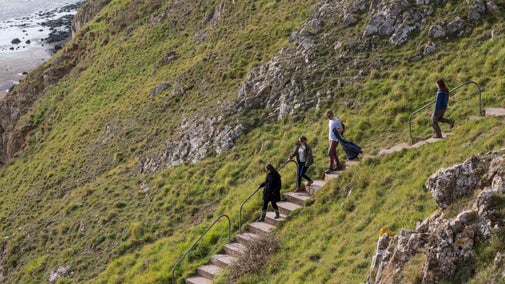
Bin Combe butterfly walk
A challenging trail through tall, dense bracken on steep slopes near Dunkery Beacon in the north of Exmoor National Park. This is by far the best place to go in pursuit of the rare heath fritillary butterfly, especially on warm, sunny days between late May and early July.
Ticks
The area is heavily infested by ticks, so take precautions. Wear long trousers tucked into socks and carefully check yourself immediately after your visit.
Total steps: 6
Total steps: 6
Start point
Dunkery Beacon car park, grid ref: SS905410
Step 1
From the car park, head left along Dunkery Hill lane. Go past the vehicle barrier, near a twisted moorland hawthorn bush, and cross rough heather on your left to reach the little valley of Bin Combe. In partnership with the Butterfly Conservation Society, we've done a lot of work to conserve the heath fritillary on Exmoor through robust bracken management.
Step 2
Follow the east side of the stream at the top of the combe and walk downhill. Stay on this east side throughout your walk. You'll hopefully begin to see heath fritillaries about 272 yards (250m) into the combe. Keep a look out for adders here.
Step 3
There is a vague path at first but once you pass a rock outcrop, near the start of the woodland, the path vanishes. Don't worry, this is normal for Bin Combe, just stick to the lower slopes and continue downwards.
Step 4
Heath fritillaries tend to be best sighted in the lower combe, but vary in location from year to year. They also live in gorse glades.
Step 5
Turn left on to a clear but rough track towards the bottom of the combe, near a stream crossing. Follow this path north-east. You may see dark green fritillary and small pearl-bordered fritillary here. Also, check the tops of gorse bushes for little Dartford warblers.
Step 6
At a crossing of paths, take the rough stone track back uphill to the twisted hawthorn and the road. Keep an eye out for Exmoor ponies and red deer grazing the open moorland.
End point
Dunkery Beacon car park, grid ref: SS905410
Trail map

More near here

Webber's Post walk
This easy access trail for all the family takes in the rainforest surroundings of Exmoor National Park where you can discover a wealth of wildlife.

Walking in Exmoor: Day one
Discover an 8-mile walk through Selworthy village to Selworthy Woods. Take in far-reaching panoramic views from Selworthy Beacon before descending to Bossington's pebble beach. Enjoy history with coastal and countryside views along the way.

Walking in Exmoor: Day two
Tackle day two of the Exmoor walking challenge. It's a more challenging stretch but it's well worth the effort as you discover Heath fritillary butterflies on your route.
Get in touch
Our partners

We’ve partnered with Cotswold Outdoor to help everyone make the most of their time outdoors in the places we care for.
You might also be interested in

Walking in Somerset
From the majestic crags of Cheddar Gorge and the sea views at Bossington to gentle strolls through Tudor parkland at Montacute House, these are some of the best walks in Somerset.

Things to do around Webber's Post
Explore Webber's Post, Exmoor’s highest point, and enjoy spectacular views over Horner Wood and the wild expanse of moorland stretching up to Dunkery Beacon.

Top tips for butterfly spotting
Learn how to spot butterflies without scaring them away, and find out what types of plants will attract them to your garden.

Walks through colourful heathland
Enjoy the seasonal spectacle of purple heather in bloom with these walks across heathland and moorland.

Walking
Explore some of the finest landscapes in our care on coastal paths, accessible trails, woodland walks and everything in between. Find the best places to walk near you.

Cotswold Outdoor: our exclusive walking partner
Learn about the National Trust’s ongoing partnership with Cotswold Outdoor. Find out how they help us care for precious places and the exclusive discount available for National Trust supporters.

Follow the Countryside Code
Help to look after National Trust places by observing a few simple guidelines during your visit and following the Countryside Code.

Staying safe at National Trust places
The special places in National Trust care sometimes come with a few risks for visitors, be it coastline or countryside. Find out how to keep safe throughout your visits.